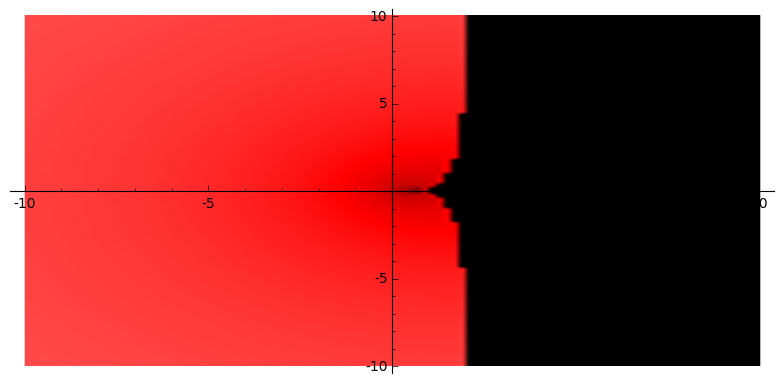Revision history [back]
 | 1 | initial version |
Not entirely sure why you assume v is complex and want to plot it when v∈[−1,7].
Perhaps this is what you want to use (?).
complex_plot(lambda v: abs(matrix(CC, [[0,1,0,0],[-v,1-v,0,0],[0,-v,1-v,0],[0,0,1,0]]).eigenvalues()[0]),(-10,10),(-10,10))Sample output:

Although, then you may want to drop the abs to get:

 | 2 | No.2 Revision |
Not entirely sure why you assume v is complex and want to plot it when v∈[−1,7].
Perhaps this is what you want to use (?).use.
complex_plot(lambda v: abs(matrix(CC, [[0,1,0,0],[-v,1-v,0,0],[0,-v,1-v,0],[0,0,1,0]]).eigenvalues()[0]),(-10,10),(-10,10))Sample output:


Although, then you may want to drop the abs to get:


If you are just interested in the case where v∈R and want to plot the module of the eigenvalue then
plot(lambda v: abs(matrix(CC, [[0,1,0,0],[-v,1-v,0,0],[0,-v,1-v,0],[0,0,1,0]]).eigenvalues()[0]),(x,-20,10))will do the job.

Update: Added case where v∈[1,7].
 | 3 | No.3 Revision |
Perhaps this is what you want to use.
complex_plot(lambda v: abs(matrix(CC, [[0,1,0,0],[-v,1-v,0,0],[0,-v,1-v,0],[0,0,1,0]]).eigenvalues()[0]),(-10,10),(-10,10))Sample output:

Although, then you may want to drop the abs to get:

If you are just interested in the case where v∈R and want to plot the module of the eigenvalue then
plot(lambda v: abs(matrix(CC, [[0,1,0,0],[-v,1-v,0,0],[0,-v,1-v,0],[0,0,1,0]]).eigenvalues()[0]),(x,-20,10))will do the job.

Update: Added case where v∈[1,7].v∈R.

